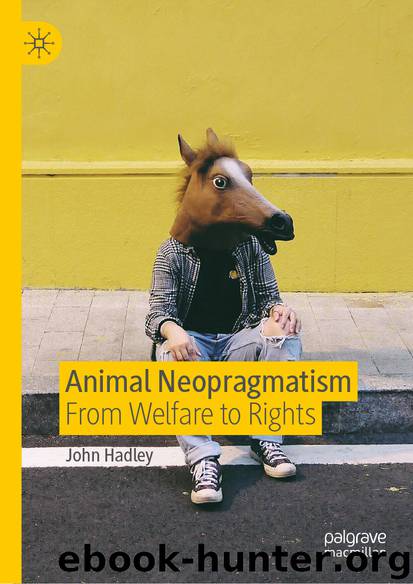Animal Neopragmatism by John Hadley

Author:John Hadley
Language: eng
Format: epub
ISBN: 9783030259808
Publisher: Springer International Publishing
The Changing the Subject Problem
There is a danger, however, with interpreting folk concern for welfare as wholly at odds with the specialist animal welfare orthodoxy. Rightly or wrongly, an ostensibly hedonistic view is the default view of welfare for public policy purposes. Scientific evidence of measurable suffering is powerful support for evidence-based public policy. Even animal advocates that would like to see the concept of welfare broadened beyond an exclusive focus on feelings, will draw upon the specialist view when it suits their purposes. The normative significance of aversive feeling is well-established and continues to be an important element in debates about the treatment of animals.
If public concern is interpreted as support for a nonhedonistic conception of welfare, however, then the task of moving welfare in a progressive direction will be exceedingly difficult. It will be difficult to disguise any progressive change to welfare as consistent with the existing paradigm. Indeed, if nonhedonistic considerations such as dignity, respect, natural living and bodily integrity are logically disconnected from feelings, then showing concern for them will amount to calling for a change of subject (Hadley 2017). In effect, when a person draws attention to, say, bodily integrity, they will be talking about something else other than welfare.
What’s needed to better align the orthodox view of welfare with the folk view is a way of interpreting concern for nonhedonistic considerations as a concern for animals that is in sync with animal welfare hedonism. In other words, it needs to be shown that, when citizen’s appeal to dignity or integrity or natural living, they are showing concern for an animal’s subjective experiences. In what follows, I present two ways of achieving that objective. The first is via a version of the theory of welfare known as experiential pluralism (van der Deijl 2018); the second is by drawing upon elements of neopragmatism, specifically, the theory of language use known as expressivism.
Download
This site does not store any files on its server. We only index and link to content provided by other sites. Please contact the content providers to delete copyright contents if any and email us, we'll remove relevant links or contents immediately.
| Administration & Medicine Economics | Allied Health Professions |
| Basic Sciences | Dentistry |
| History | Medical Informatics |
| Medicine | Nursing |
| Pharmacology | Psychology |
| Research | Veterinary Medicine |
The Ultimate Pet Health Guide by Gary Richter(1742)
All Things Bright and Beautiful by James Herriot(1726)
Vet in Harness by James Herriot(1679)
Predation ID Manual by Kurt Alt(1666)
Chimpanzee Politics: Power and Sex among Apes by Frans de de Waal(1497)
Young James Herriot by John Lewis-Stempel(1496)
Veterinary Echocardiography by Boon June A(1399)
The Natural Sciences: A Student's Guide by John A. Bloom(1377)
All Things Wise and Wonderful by James Herriot(1342)
Creatures of the Rock by Andrew Peacock(1341)
Vet in a Spin by James Herriot(1326)
Exotic Animal Hematology and Cytology by Campbell Terry W(1296)
Zoo Tails by Oliver Graham Jones(1292)
Black's Veterinary Dictionary by Edward Boden(1279)
Dr. Kellon's Guide to First Aid for Horses by Eleanor Kellon(1277)
David Sedaris Diaries by David Sedaris(1265)
Dr. Pitcairn's Complete Guide to Natural Health for Dogs and Cats by Richard H. Pitcairn & Susan Hubble Pitcairn(1179)
Calisthenics: Core CRUSH: 38 Bodyweight Exercises | The #1 Six Pack Bodyweight Training Guide by Pure Calisthenics(1148)
A Handful of Happiness by Massimo Vacchetta & Antonella Tomaselli & Jamie Richards(1136)
